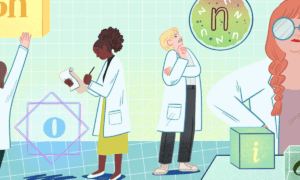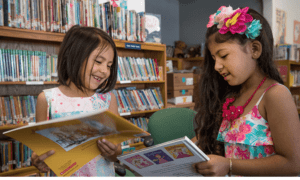Implementing the ‘Science of Reading’: The Behind the Scenes Work

Numerous fields of study have contributed to what is known as “the science of reading,” an extensive collection of empirical studies about reading and writing. This information is based on thousands of studies in different languages accumulated over the last fifty years of research worldwide.
What is the Science of Reading?
Numerous fields of study have contributed to what is known as “the science of reading,” an extensive collection of empirical studies about reading and writing.
This information is based on thousands of studies in different languages accumulated over the last fifty years of research worldwide.
Reading research has led to a wealth of information that can help us understand how students become proficient readers and writers, why some struggle, and how to evaluate and instruct students in the best way possible to help them overcome their reading challenges?
Science of Reading: A Comprehensive Reference
Reading research has led to a wealth of information that can help us understand how students become proficient readers and writers, why some struggle, and how to evaluate and instruct students in the best way possible to help them overcome their reading challenges?
The term “the science of reading” has become popular in recent years, which could cause confusion, even though the scientific basis for good reading has existed for decades. To help all parties comprehend the science of reading and its ability to revolutionise teaching, The Science of Reading: Defining Guide offers a clear explanation of the field and its limitations.
How Can We Interpret Reading Research for Use in Phonics Lessons?
Reading research has identified phonics education as one of the critical components of effective reading instruction. The scientific community has unanimously concluded that phonics must be taught in a systematic, explicit, and cumulative manner.
Going Unnoticed
Reading education based on “cueing” is still used by some schools, either in place of or in addition to phonics instruction. Is that word new to you?
- Even if they’re unfamiliar with the term “three cueing,” most teachers will have heard of “MSV.” M represents “meaning,” S represents “sentence structure,” and V represents “visual information,” or the letters in the words, to determine their meaning.
- But as reading science has progressed, “three cueing,” now called “whole language,” has been supplanted. The original concept regarding cues was based on visual cues. However, a recent scientific study has demonstrated that proficient readers can decipher words independently of context.
The Five Cornerstones of Teaching Students to Read Scientific Texts?


These five factors were highlighted in the 2000 study of the National Reading Panel (NRP) as crucial to reading success:
- Knowledge Acquisition
- Ability to
- Phonics and Vocabulary
- Developing Fluency in Phonetics
- Now, let’s delve deeper into phonemic awareness and phonics.
Developing Fluency in Phonetics
Phonemes are the building elements of words and are the basis of practical basic literacy skills.
- To assist youngsters in becoming competent readers, it is essential to work with their phonemic awareness or the concept that graphemes (sequences of letters that represent sounds) are related to phonemes (sounds).
- The purpose of teaching phonemic awareness in grades K –2 is to help children use the automatic decoding skills they’ve learned via direct phonics instruction to begin decoding novel words independently.
- Second graders can expect to remember 1,000 to 7,500 words. Having pupils commit every phrase or pattern of phonemes or graphemes to memory is an impractical expectation. By providing kids with targeted instruction in essential reading and writing skills, we empower them to become lifelong learners. The “Self-Teaching” model is a popular term for this.
Three Components of Phonics Lessons Based on Science. Three things are necessary for phonics training to be practical, according to science:
- A practical method. Taking the next step: practising Illustrating the practical use for spelling and reading. Students need to master decoding, one of the most basic reading abilities, and these three routines will help them do just that. Assisting pupils in becoming cognitively automatic is crucial for decoding. In other words, they can recognise a word just by looking at it without needing to hear it out. In conversations about “sight words,” this is often called.
-
While picking up a language is second nature, reading is not. In what sequence are the abilities needed to become proficient readers, according to what we know from reading research? We pick up the spoken language as a foundation for word acquisition. The phonetic structure of words is taught to us. We can separate phonemes, and one approach to do this in the classroom is to focus on the initial sound of words.
- An effective strategy is to use the initial sound of the pupils’ names. The first stage of methodical, explicit education is to concentrate on noises… sound isolation is merely the initial stage in developing pupils’ phonemic awareness; unlike “balanced literacy” or other “cueing”-based methods, the ultimate goal is for them to decode every single sound in a word without the use of guesswork.
-
Framing the orthographic dictionary. As we discovered before, children can only acquire phonics independently if they develop cognitive automaticity. Students develop an automatic decoding lexicon as they gain experience decoding words. Students can be introduced to phonemes methodically through stories and activities. Practice, modelling, and reinforcement are essential to developing the mental muscle memory required for phonemic awareness.
- One can learn phonemic awareness by direct instruction, observation, and practice. A series of steps leading to complicated mixing activities begins with phoneme isolation.
Part 2 of the Science of Reading


Participate in a free online Science of Reading workshop by clicking here.
- How to Become an Alphabet Master. When multisensory education approaches are used in more advanced classroom lessons, children will learn more sophisticated phoneme operations, such as deconstructing words into their separate phonemes. Phoneme substitution is the highest level of phonemic awareness.
- Through instructing in abilities like Splitting up amalgamating. Through explicit and systematic manipulation, children develop the ability to execute phoneme substitution, a crucial skill for becoming independent readers. This method of teaching helps children pick up new vocabulary as they read.
- The Science of Reading and the Alphabetic Principle: What Are They? According to the alphabetic principle, letters represent sounds, and words are formed from those sounds. Improving one’s reading abilities relies heavily on the alphabetic principle. We support the transition from phonemes to graphemes or sounds to speech as a group.
- Learning the alphabetic principle as students transition from spoken to written language helps them avoid making guesses or mistakes when decoding, which is especially important for those entering kindergarten who need a foundational understanding of the principle. Students strengthen their skills in using the alphabetic principle to link graphemes to phonemes through deliberate, organised practice.
- What is the relationship between the alphabetic principle and phonics? Learning the phonetic relationships of the English language is known as phonetics. In phonetics, the principle of the alphabet is put into practice. Students who have mastered phonetics are better able to read words they have never encountered before. Systematic and explicit instruction is key in phonics education to help students become fluent in automatically connecting graphemes to phonemes.
Case in point: closed syllables
Each syllable that begins with a vowel and ends with a consonant is considered a closed syllable. When a syllable is closed, the vowel typically represents a brief sound. In the English language, 53 per cent of syllables are closed.
Our approach includes the usage of letter tiles, both digital and actual, in the classroom. You might be familiar with these. Students learn that words are made up of sounds and that the letters of a phrase correlate to those sounds by matching the sounds to the letters on the letter tiles.
The objective is to empower students with a decoding strategy they may employ when faced with new or unfamiliar words. This will prevent them from relying on the “3 cues” employed by struggling readers. Remember the text: “Readers who have not been taught phonemic awareness should be encouraged to think critically about the word.”
The Science of Reading and Words with Multiple Syllables
Multisyllabic words are the next step after pupils have mastered the alphabetic principle. Multisyllabic words can be easily broken down into their separate syllables with the help of our SyllaBoardsTM.
We already mentioned that 53% of English syllables are closed. Students who have mastered decoding these and other typical syllable types can then use that knowledge to expand their orthographic vocabulary.
Reading new words allows students to concentrate on reading to understand, a goal emphasised in federal and state standards besides reading.
Reflecting on Visual Words
Just because a word appears in sight doesn’t mean it occurs frequently. Grown-ups can see thirty thousand to seventy thousand words. However, explicit memorisation training did not lead to memorising these terms. Instead, reading these “sight words” becomes instinctive, without requiring conscious thought, as kids get familiar with graphemes and syllables as a manner of decoding words.
Master Calculus with These Top Books and Easy Steps


Not All Sight Words Have a High Frequency
Many lists of sight words, which appear frequently in written language, may be recognisable to you. Examples of such lists are the Fry Word and the Dolch 220 lists.
Even though high-frequency words tend to be irregular, sight words encompass much more than that.
An example of an irregular word is “eight,” which originates in Old English spelling. A phonetic approach to learning to interpret common irregular words is more effective than “blended literacy” methods that rely on rote memory or guesswork.
Word Magic for the Heart: A Scientific Study of Sight Words
Heart Word Magic is based on the phonetic method of teaching sight words. Students learn these challenging words in a phonetic style using Heart Words.
Research shows that after children decode a word multiple times, it can be anchored in their sight word memory. At the beginning of the curriculum, we cover the phoneme-grapheme relationship;
however, sound-sight awareness cannot be achieved through rote memorisation of sight words. Visit our blog at Make Tricky Sight Words Sticky to learn about Heart Word Magic.
A Virtual Workshop on the Science of Reading
Come and be a part of a free two-part Science of Reading Virtual Workshop, where educators can learn strategies to help students learn to decode better.
Each session covers about three hours of material. Important details regarding the methods that studies found most effective in teaching the foundational reading skills necessary for excellent decoding and fluency are included here.
If you make it through the entire webinar, you’ll get 6 CEUs and access to Part 3 whenever possible. The Science of Reading is taught by knowledgeable presenters at our workshop, which is devoted entirely to professional development and includes no product demonstrations.
The Unseen Handiwork of Applying the “Science of Reading”
To bring reading education in line with current research and best practices, 38 states have enacted rules or laws about reading instruction reform.
It might be challenging for individual schools to unpack its many principles, implement a new curriculum, and maintain consistency throughout implementation.
In most circumstances, the principal is the primary figure responsible for managing this intricate transformation.
With the responsibilities of supervising, mentoring, and evaluating juggling, principals must drive implementation. Principals are expected to be well-versed in all lesson plans to provide insightful criticism, which is a detailed and broad responsibility. In addition to implementing the new curriculum, they must provide the groundwork for it by rearranging school hours and making room for professional development.
Principals have frequently been marginalised in education reform despite their crucial role in changing school-wide practice. The reading legislation that states have quickly passed must also define everyone’s precise function or duty.
For a leader in the education system, reform has always focused on the classroom. They see to it that educators have all the resources they require. Instruction Partners collaborates with school districts to train teachers and principals on implementing evidence-based curricula.
However, “very rarely do we think through what principals need to know and do to make this change happen,” stated Emily Freitag, CEO of Instruction Partners.
Education Week recently interviewed multiple principals for a series of articles that focused on three essential aspects of their jobs. This is what they stated:
1. School Leaders Should Always be Willing to Learn More.


- School leaders should have a firm grasp of the research behind reading acquisition and the best teaching techniques for their students. The principals aren’t familiar with reading instruction or its methods, so this isn’t easy for them.
- Like teachers, principals need training on the new curriculum and how to implement it, which helps them turn research into practice.
- When Quinena Bell, principal of Hobgood Elementary School in Murfreesboro, Tennessee, completed the course, reading took on a new meaning.
- My experience as an academic coach led me to believe that I had a firm grasp of reading education. However, according to Bell, some techniques, such as separating reading and writing, harm children more than reasonable.
In The So-Called “Science of Reading,” Principals Play a Pivotal Role. Will They Be Able?
Nathaniel Messick, a principal from northwest Minnesota, is one of several who have sought out leader-focused training in the fundamentals of reading instruction based on research. The experts noted that administrators can accomplish two things more effectively when they are forthright about knowing the science and the curriculum.
- First, students have a complete picture of the interconnectedness of the many components of the curriculum both within and across grade levels.
- Secondly, once administrators have a good grasp of the curriculum’s overall goals and timeline, they may assist in distributing information to instructors in manageable portions. When the Seaford school district in Delaware adopted a new reading curriculum nearly ten years ago, elementary school administrator Kirsten Jennette did precisely that.
- I made it a point to study in chunks. “My teachers thought the same thing,” Jenette remarked. Reading aloud from grade-level literature is one example of a singular educational approach they could employ. All of my comments and our professional development were based on that initial unit of study. That way, it wasn’t that intimidating.
- Additionally, principals lay the groundwork for transformation. Principals must be able to switch gears quickly and adeptly between managing programs and leading instruction.
- Messick is finalising a new professional development calendar to accompany the new reading curriculum, which will be implemented during the 2024–25 academic year. Messick has planned a weekly early release from school to provide teachers with the necessary training without affecting non-contractual time.
- Chandra Phillips, like Messick, had to balance competing demands to give her teachers adequate time to develop lesson plans. Seaford, Delaware’s Central Elementary School principal Phillips brought timers into classrooms to acquaint teachers with the new reading curriculum’s three 45-minute chunks.
- Doing it well might be challenging. Finding more time in the school day to work with students reading below grade level has been difficult for Dana Perez, the principal of Pembroke Elementary School in Danbury, Connecticut, and her colleagues.
- Equitable grouping is the foundation of our program. According to Perez, our educators have found it challenging to keep a closer eye on these groups and record their development.
Third, A Principal Has to Strike a Balance Between Being too Strict and Being too lazy with Project Execution.


When principals introduce new curricula, their enforcement is often more stringent.
During “learning walks” with her instructional coaches, Murfreesboro principal Bell observes teachers in the classroom.
- For example, she makes sure that lessons on letter decoding come before writing and subject knowledge building and are taught in a specific order. When instructors go on learning walks, it’s easy to see where they might have messed up.
- “Scaffolding was done excessively by teachers at times. According to Bell, “some teachers wouldn’t let that happen” even though the curriculum explicitly called for students to engage in “productive struggle” with the readings.
- Bell had to urge them not to be too forthcoming with responses gently.
- During her observations, Perez found that teachers who should have set up basic routines at the beginning of the rollout had a more challenging time sticking to the curriculum in the following weeks.
- Additionally, educators may push back against change. Thus, administrators may need to use all of their managerial tools.
- Jennette encouraged her instructors to voice their concerns about the new curriculum. She even relayed their inquiries to those responsible for creating it. She tried to make the point that instructors could stay within the prescribed curriculum.
- Bell also stood firm with her instructors. They shouldn’t be able to resist change just because they had done things a certain way before the new curriculum,” she admonished.
- Leadership figures like Phillips can shift from enforcer to facilitator once the initial rollout is complete and teachers have had some experience with the curriculum. They can then encourage instructors to exchange methods and insights with each other.
Visit blogkingworld.com, and I will share more useful articles, stories and information if you find this educational article helpful. To learn even more tips on learning, business, health and fitness, climate change and more, subscribe to my LinkedIn.




